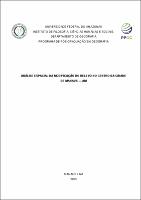| ???jsp.display-item.social.title??? |


|
Please use this identifier to cite or link to this item:
https://tede.ufam.edu.br/handle/tede/10886| ???metadata.dc.type???: | Dissertação |
| Title: | Análise espacial da modificação do relevo no centro da cidade de Manaus — AM |
| Other Titles: | Spatial analysis of landform modification in downtown Manaus — AM |
| ???metadata.dc.creator???: | Oliveira, Giovani Gabriel Santos de  |
| ???metadata.dc.contributor.advisor1???: | Fortes, Mircia Ribeiro |
| ???metadata.dc.contributor.referee1???: | Albuquerque, Adorea Rebello da Cunha |
| ???metadata.dc.contributor.referee2???: | Oliveira, Ercivan Gomes de |
| ???metadata.dc.description.resumo???: | A dissertação investigou as transformações do relevo no centro da área urbana de Manaus, destacando as modificações decorrentes da ocupação humana desde o período pré-colonial até os dias atuais. O objetivo central é analisar como o relevo foi alterado ao longo do tempo em função do crescimento urbano e das intervenções estruturais. A metodologia adotada segue a proposta de Libault (1971), que estrutura a pesquisa em quatro níveis: compilatório, correlativo, semântico e normativo. Esses níveis abrangem desde a coleta de dados em textos, documentos e mapas, até a análise e representação gráfica por meio de mapas temáticos, cartas e fotografias, facilitando a interpretação das modificações do relevo. Os resultados evidenciam que, inicialmente, a ocupação de Manaus mantinha uma relação de equilíbrio com o meio natural. A chegada dos colonizadores portugueses trouxe as primeiras intervenções, como a construção do porto e da Fortaleza de São José do Rio Negro. Contudo, o Ciclo da Borracha marcou uma mudança drástica, com a europeização da cidade e grandes obras de infraestrutura, como a canalização de igarapés e a criação de áreas aterradas. Tais mudanças alteraram a morfologia original, eliminando barreiras naturais e expondo a cidade a novos riscos estruturais. Muitas galerias subterrâneas, hoje deterioradas, representam um risco iminente para a segurança urbana e o patrimônio histórico. A pesquisa contribui para os estudos urbanos e geográficos ao integrar aspectos históricos e geomorfológicos, destacando a importância do planejamento urbano sustentável. O alerta sobre o estado atual das galerias e a ausência de registros sistematizados reforça a urgência de novas investigações e políticas de prevenção. Assim, o trabalho além de amplia o conhecimento sobre a evolução do relevo urbano de Manaus, propõe uma reflexão sobre práticas urbanísticas mais sustentáveis e integradas ao ambiente natural. |
| Abstract: | The dissertation investigated the transformations of the relief in the central urban area of Manaus, highlighting the modifications resulting from human occupation from the pre-colonial period to the present day. The main objective is to analyze how the relief has changed over time due to urban growth and structural interventions. The adopted methodology follows Libault’s proposal (1971), which structures the research into four levels: compilatory, correlative, semantic, and normative. These levels range from data collection in texts, documents, and maps to the analysis and graphic representation through thematic maps, charts, and photographs, facilitating the interpretation of relief modifications. The results show that Manaus initially maintained a balanced relationship with the natural environment. The arrival of Portuguese settlers brought the first interventions, such as the construction of the port and the Fortaleza de São José do Rio Negro. However, the Rubber Boom marked a drastic change with the Europeanization of the city and major infrastructure works, such as the canalization of streams and the creation of reclaimed areas. These changes altered the original morphology, eliminating natural barriers and exposing the city to new structural risks. Many underground galleries, now deteriorated, pose an imminent risk to urban safety and historical heritage. The research contributes to urban and geographic studies by integrating historical and geomorphological aspects, highlighting the importance of sustainable urban planning. The warning about the current state of the galleries and the lack of systematic records emphasizes the urgency of further investigations and preventive policies. Thus, the work not only expands knowledge on the evolution of Manaus' urban relief but also proposes a reflection on more sustainable and environmentally integrated urban practices. |
| Keywords: | Geografia física Geomorfologia Relevo (Geografia) Planejamento urbano Urbanização |
| ???metadata.dc.subject.cnpq???: | CIENCIAS HUMANAS: GEOGRAFIA: GEOGRAFIA REGIONAL |
| ???metadata.dc.subject.user???: | Geomorfologia urbana Transformação do relevo Urbanização histórica Ocupação humana |
| Language: | por |
| ???metadata.dc.publisher.country???: | Brasil |
| Publisher: | Universidade Federal do Amazonas |
| ???metadata.dc.publisher.initials???: | UFAM |
| ???metadata.dc.publisher.department???: | Instituto de Filosofia, Ciências Humanas e Sociais |
| ???metadata.dc.publisher.program???: | Programa de Pós-graduação em Geografia |
| Citation: | OLIVEIRA, Giovani Gabriel Santos de. Análise espacial da modificação do relevo no centro da cidade de Manaus — AM. 2025. 118 f. Dissertação (Mestrado em Geografia) - Universidade Federal do Amazonas, Manaus, 2025. |
| ???metadata.dc.rights???: | Acesso Aberto |
| ???metadata.dc.rights.uri???: | https://creativecommons.org/licenses/by-nc-nd/4.0/ |
| URI: | https://tede.ufam.edu.br/handle/tede/10886 |
| Issue Date: | 27-Mar-2025 |
| Appears in Collections: | Mestrado em Geografia |
Files in This Item:
| File | Description | Size | Format | |
|---|---|---|---|---|
| DISS_GiovaniOliveira_PPGEOG.pdf | 26.51 MB | Adobe PDF |  Download/Open Preview |
Items in DSpace are protected by copyright, with all rights reserved, unless otherwise indicated.




